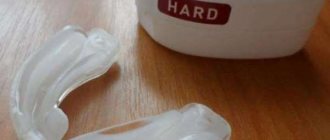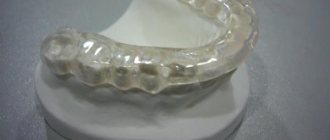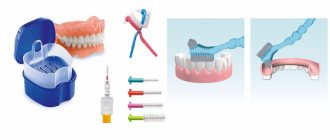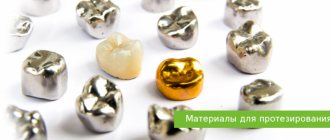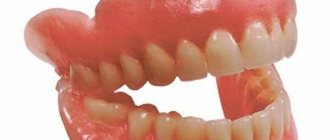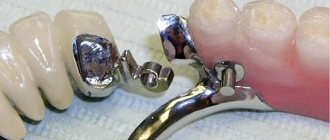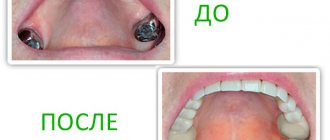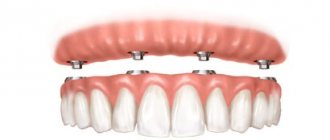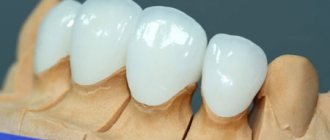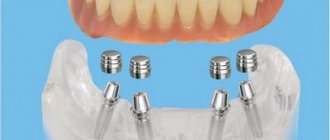Today, only newborns do not have problems with teeth and only temporarily, until teething. Diseases, heredity, poor ecology of St. Petersburg - they play as a team and harmoniously against healthy strong teeth, and sometimes we ourselves score a “goal” by neglecting hygiene and regular visits to the dentist. When awareness of the problem comes, it turns out that it is impossible to do without prosthetics, because one or more units are missing in the dentition.
The aesthetic and functional problem is solved by bridge prosthetics - high-quality crowns cannot be distinguished from “native” ones, and the load on the gums when chewing is distributed evenly.
What is dental bridge prosthetics?
This is a non-removable prosthesis that is attached to supports - the patient’s outermost teeth to the defect or implants if the outermost teeth are removed. The false teeth located between the supports are called the “body” of the bridge. The designs differ in the installation method and material of manufacture.
The procedure for installing a bridge is carried out in several stages, and depending on the quality of the material, it lasts up to 15 years .
Indications and contraindications for the installation of bridges
The supporting teeth on which the bridge will be installed must be healthy to withstand the additional load. If necessary, the teeth are first treated or removed and implants are installed.
Indications:
- Missing one molar
- Absence of 1-4 teeth in the lateral and anterior zones of the dentition
Contraindications:
- Missing more than 4 teeth in a row
- Bruxism
- Periodontitis
- Malocclusion
- Inflammatory processes in the oral cavity
- Pathologies of the jaw bone tissue
- Insufficient oral hygiene
- Blood diseases
- Psychical deviations
- Exacerbation of chronic diseases
Most contraindications are not absolute; after eliminating malocclusion defects, treating caries, and pathologies of the jaw bone tissue, dental prosthetics with bridges can be performed.
Basic rules of care
Careful care of the prosthesis is a guarantee of its long-term operation. At the same time, it is important to pay attention to hygiene: it is necessary to clean the bridge, as well as the places where it adjoins the supporting dental units, at least 1-2 times a day. This will avoid the accumulation of food debris in this area and the development of infectious processes.
Experts recommend using gentle products that do not contain solid particles to eliminate the possibility of damage to the prosthesis. Also an important condition for the durability of the product is regular visits to a specialist for preventive purposes.
Pros and cons of bridge structures
The main advantages of bridge prosthetics:
- Depending on the material, dentures last from 5 to 15 years . If high-quality implants are installed, the service life can be above 20 years.
- Installing a bridge is cheaper than implanting each tooth separately. Although the last method is the best solution.
- Fixed structures are more convenient than removable ones - they do not cause discomfort, and you don’t have to be afraid that they will fall out at the most inopportune moment. The cleaning procedure is no different from the hygiene of your own teeth.
- Quick adaptation to artificial teeth.
There are also some downsides:
- Fixing a bridge requires preparation of the supporting teeth - they are ground down and the nerves are removed. A pulpless tooth becomes fragile because it does not receive adequate nutrition, which means it is destroyed faster than a living one.
- In addition to daily brushing in the morning and evening, we must not forget about thoroughly rinsing the mouth and be sure to have professional hygienic cleaning done by a dentist.
- The load on the supporting teeth increases, which can lead to their complete destruction.
Attending doctors at the Elident clinic
Mlodik Boris Naumovich
Dental surgeon, implantologist, orthopedist
Clinical experience : 26 years
Vakhrushev Alexander Viktorovich
Dental surgeon, implantologist, orthopedist
Clinical experience : 25 years
Preparation of supporting units for installation of prostheses
In most cases, natural crowns, on which a permanent bridge will be fixed in the future, are subject to pulp removal. This is due to the high probability of injury to the neurovascular bundle during turning. However, when a metal-ceramic structure is put on, there is no need to remove the nerve in large dental units, since they have denser walls.
You can also keep your natural teeth alive if you install a ceramic bridge. The ability to preserve the nerve is considered necessary, since this has a positive effect on the strength and durability of natural units.
When it is planned to install a bridge, the cost of depulpation and subsequent filling is determined by the number of root canals, and can range from 2,500 to 5,000 rubles, respectively.
If, after the loss of a tooth, healthy, living crowns remain nearby, the possibility of grinding them down for a future bridge is considered undesirable. The same goes for nearby units that previously had small seals installed. In such situations, it is advisable to install one implant: its cost will cost you less than installing a bridge.
It is recommended to install a bridge in Moscow only when the teeth located on the border with the missing one were previously filled by 50% or were subjected to depulpation.
Types of bridges, which ones to choose?
They are divided into two large groups: according to material and manufacturing method.
Materials:
- Metal-plastic . Refers to temporary bridges. The design is lightweight, installation is carried out in a maximum of three visits, and the service life is 1-3 years. Metal-plastic bridges have a peculiarity - they are installed only on implants. The material is short-lived and is not recommended for use on living teeth unless necessary. They are convenient in cases where there is no time to install durable bridges - the metal-plastic material is flexible and allows you to make crowns in a very short time.
- Plastic . A budget solution that also applies to temporary bridges is plastic, like metal-plastic, a short-lived material. At the same time, the design is lightweight, and patients quickly get used to the bridges. The plastic bridge prosthesis does not cause allergies and well imitates the natural color of enamel and the anatomical shape of the fissures. It is usually installed if the patient is short on money or while permanent dentures are being made.
- Metal-ceramic . A modern and aesthetic alternative to metal bridge structures, which, although durable, look ugly. The ceramic veneer is matched to the natural color of the patient’s teeth, and the metal frame, which can be quite extensive, firmly connects the parts of the bridge. But it is not recommended to install dentures and metal-ceramics in the smile area - the metal noticeably shines through the ceramics.
- Ceramic . An all-ceramic bridge is not as durable as a metal-ceramic bridge, but has excellent aesthetic characteristics. Ceramics very accurately recreates the appearance of dental tissues - from color to the natural transparency of enamel.
Manufacturing methods and degree of fixation:
- Agdesive (adhesive) . What is an adhesive bridge in dental prosthetics? This is a gentle modern solution to the problem of missing teeth. With this method, healthy supporting teeth are not ground down into a stump and are not depulped - the body of the prosthesis is attached using a beam structure, special glue or splinting. The biggest drawback is that you cannot install more than one or two units. The average service life is 5 years, with proper care - 10 years. Adhesive bridge prosthetics is convenient because at any time the patient can remove the prosthesis and install another type of structure without any problems.
- Solid cast . Solid bridges are made from a variety of alloys and are cast as one piece. This method eliminates errors, material heterogeneity and soldering inaccuracies, as in soldered bridges. They are distinguished by modeling accuracy and durability in use. Lined with ceramics and plastic to imitate tooth enamel.
- Soldered . Stamped soldered bridges have been known since Soviet times and have more disadvantages than advantages. To make a hard copy of the prosthetic tooth, it is compressed with a metal thin-walled sleeve. The continuity of the connection of the crowns is ensured by subsequent soldering of the joints. At the same time, the prosthesis does not have a high precision of fit, which means that it is impossible to recreate the anatomically correct shape of the tooth. This deficiency leads to the development of repeated caries, destruction and removal of the supporting tooth.
- On implants . The missing abutment tooth is replaced by an implant - an artificial root onto which a crown is attached. It reliably fixes the bridge, has a long service life, can withstand heavy chewing loads and is suitable for restoring any units in the dentition. Dental implantation with bridges is one of the most expensive but durable ways to eliminate defects.
- Cantilever bridges are used for the front teeth of the smile line. The main difference is the presence of one support for the bridge. Cantilever bridges cannot be used to replace molars and premolars - excessive load during chewing will lead to their loosening and loss.
- Combined - combine removable and non-removable types of structures. Cement or screws on implants are used to secure the fixed part of bridges; the removable part is the crowns of the prosthesis.
Preparing the oral cavity for prosthetic bridges
Before installing bridges, the doctor will definitely sanitize the oral cavity, take an OPTG photo (orthopantomogram), and possibly give a referral for additional tests. This is necessary for the dentist to assess the condition of the teeth and jaw bone tissue and identify problems that require solutions before installing dentures.
Preparation is carried out comprehensively:
- Therapeutic – professional cleaning of supragingival and subgingival plaque, gum treatment, caries elimination, pulp removal.
- Surgical – removal of teeth that cannot be treated, removal of bone growths (osteophytes, exostoses), osteoplasty, implantation, sinus lifting.
- Orthodontic – bite defects are eliminated using braces, plates, and aligners.
- Orthopedic – defects of secondary deformation of teeth that arise after the removal of adjacent units or antagonizing ones (on the opposite side of the jaw) are corrected.
Stages of installing a dental bridge
- The dentist evaluates your oral health and identifies and corrects problems.
- Abutment teeth are removed and ground down or implants are implanted.
- After preparation, the doctor makes an impression of the jaws, according to which the bridge will be made.
- While permanent, durable dentures are being made in a dental laboratory, the dentist may install a temporary dental bridge to hide the defects.
- Bridge installation. Dental bridges are secured to supporting teeth using cement or clasps.
The price of dental bridges in dentistry depends on the pricing policy of the clinic, the professionalism of the dentists working there, the material and method of fixing the prosthesis. To find out exactly the cost of prosthetics, we invite you to a consultation at our clinic (St. Petersburg).
You need to understand that caring for newly acquired teeth must be regular and of high quality. Otherwise, the risk of developing caries on the supporting teeth increases, which will lead to their loss and additional costs for restoring the dentition.
Prices
| Service | Price |
| Consultation with an orthopedic doctor | For free |
| Metal-ceramic crown (for 1 unit) | 12 900 ₽ |
| Installation | Calculated individually |
Expert of the article you are reading: Griboyedov Pavel Olegovich Implantologist, Orthopedic Dentist, leading specialist of the NovaDent network
14 years
Clinical experience
Skhodnenskaya
Khimki Boulevard, 14, bldg. 2
+7
Free consultation with this specialist

